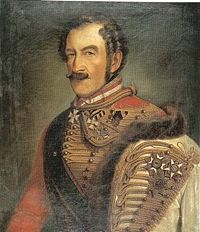Prince Ferdinand of Saxe-Coburg and Gotha
| Prince Ferdinand | |||||
|---|---|---|---|---|---|
| Prince of Saxe-Coburg and Gotha Duke of Saxony | |||||
 | |||||
| 1st Head of the House of Saxe-Coburg and Gotha-Koháry | |||||
| Tenure | 27 June 1826 – 27 August 1851 | ||||
| Successor | Prince August | ||||
| Born | 28 March 1785 Coburg | ||||
| Died | 27 August 1851 (aged 66) Vienna | ||||
| Burial | Mausoleum at Friedhof am Glockenberg, Coburg | ||||
| Spouse | Maria Antonia Koháry de Csábrág | ||||
| Issue | Ferdinand II of Portugal Prince August Victoria, Duchess of Nemours Prince Leopold | ||||
| |||||
| House | Wettin Saxe-Coburg and Gotha-Koháry (founder) | ||||
| Father | Francis, Duke of Saxe-Coburg-Saalfeld | ||||
| Mother | Countess Augusta of Reuss-Ebersdorf | ||||
Prince Ferdinand Georg August of Saxe-Coburg and Gotha (28 March 1785 – 27 August 1851) was a prince of the House of Saxe-Coburg and Gotha and a general of cavalry in the Austrian Imperial and Royal Army during the Napoleonic Wars. He established the Catholic branch of the family which eventually gained the thrones of Bulgaria (1887) and Portugal (1836).[1]: 107
Birth and family
Ferdinand was born at Coburg as Prince Ferdinand of Saxe-Coburg-Saalfeld, the second son of Francis, Duke of Saxe-Coburg-Saalfeld and of his wife, Countess Augusta Reuss-Ebersdorf. In 1826 his title changed from Prince of Saxe-Coburg-Saalfeld to Prince of Saxe-Coburg and Gotha when his brother Duke Ernst I made a territorial exchange with other members of the family.
Ferdinand's nephews and nieces included Queen Victoria of the United Kingdom and her husband Prince Albert, as well as Empress Carlota of Mexico, and her brother King Leopold II of Belgium.
Military career
On 10 December 1791 Ferdinand was commissioned as Unterleutnant in the Dragoon-Regiment Coburg Nr. 6. He was promoted to Oberleutnant on 1 March 1796 and to Second-Rittmeister on 18 November 1798. On 1 February 1802 he transferred to the Austrian Army serving in the Chevauxleger-Regiment Fürst Rosenberg in which he was promoted to Major on 29 September 1804. On 1 January 1805 he transferred to the Husaren-Regiment Graf Blankenstein Nr. 6 in which he was promoted to Oberstleutnant on 6 August 1805.
On 15 September 1808 Ferdinand became Oberst in the Husaren-Regiment Erzherzog Ferdinand d'Este Nr. 3. It was in this regiment that he served in the War of the Fifth Coalition under Field Marshal Prince Hohenzollern. He received the knight's cross of the Military Order of Maria Theresa. Before the Battle of Wagram he was named General of the Kavallerie Fürst Liechtenstein. On 15 April 1811 he was named Generalmajor.
During the War of the Sixth Coalition Ferdinand fought at the Battle of Kulm. In 1813 he fought at the Battle of Leipzig. In 1814 he received the commander's cross of the Military Order of Maria Theresa.
On 8 May 1822 Ferdinand became Inhaber (proprietor) of the Uhlanen-Regiment Fürst Karl Schwarzenberg. On 22 November 1828 he became Inhaber of the Husaren-Regiment Nr. 8. Shortly thereafter he was promoted to the rank of General der Kavallerie.
Marriage and children
In Vienna on 30 November 1815, Ferdinand married Princess Maria Antonia Koháry de Csábrág et Szitnya, daughter and heiress of Ferenc József, Fürst Koháry de Csábrág et Szitnya. When Antonia's father died in 1826, she inherited his estates in Hungary. Ferdinand then added the surname Koháry to his own.[citation needed]
Ferdinand and Antonia had four children all of whom were raised Catholic:
- Ferdinand (1816–1885); married Queen Maria II of Portugal and became Prince consort (1836) and jure uxoris King of Portugal as Fernando II (1837).
- August (1818–1881); he was the father of Tsar Ferdinand I of Bulgaria.
- Victoria (1822–1857), married Louis, Duke of Nemours.
- Leopold (1824–1884).
Death
Ferdinand died at Vienna on 27 August 1851 at the age of 66. He is buried in the ducal mausoleum at Friedhof am Glockenberg in Coburg.[1]: 47
Ancestry
| Family of Prince Ferdinand of Saxe-Coburg and Gotha |
|---|
|
|
Bibliography
- Biographisches Lexikon des Kaisertums Österreich, II, 392-394.
